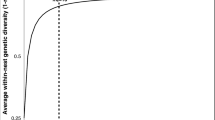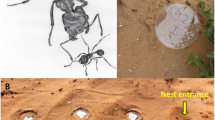Abstract
High relatedness and low genetic diversity among individuals in a group is generally considered crucial to the evolution of cooperative behaviour. However, in about a third of social insect species, intracolonial genetic diversity is increased because of derived polyandry (multiple mating by queens) and/or polygyny (multiple reproductive queens). Several studies have shown that increased intracolonial genetic diversity can enhance task performance in honey bees, but evidence of such effect in other social insects is still lacking. Why increased genetic diversity has evolved in some, but not all species, is a fundamental question in sociobiology. In this study, we investigated the effect of intracolonial genetic diversity on the task of nest migration, using the facultatively polyandrous and polygynous red ant Myrmica rubra. Genetic diversity significantly affected migration speed, but its effects were context dependent. Migration speed correlated positively with genetic diversity in one experiment in which migrations were into a known nest site, due to quicker transfer of brood into the new nest once consensus was reached. However, in a another experiment in which migration included scouting for new nest sites, migration speed correlated negatively with genetic diversity, due to slower discovery of new nest sites and slower transfer of brood into the new nest. Our results show for the first time that genetic diversity affects task performance in a social insect other than the honeybee, but that it can produce contrasting effects under different conditions.




Similar content being viewed by others
References
Abraham M, Pasteels J (1980) Social behavior during nest moving in the ant Myrmica rubra. Insect Soc 27:127–147
Aron S, Pasteels JM, Deneubourg JL, Boeve JL (1986) Foraging recruitment in Leptothorax unifasciatus: the influence of foraging area familiarity and the age of the nest site. Insect Soc 33:338–351
Avargues-Weber A, Monnin T (2009) Dynamics of colony emigration in the ant Aphaenogaster senilis. Insect Soc 56:177–183
Baer B, Schmid-Hempel P (1999) Experimental variation in polyandry affects parasite loads and fitness in a bumble-bee. Nature 397:151–154
Baer B, Schmid-Hempel P (2001) Unexpected consequences of polyandry for parasitism and fitness in the bumblebee, Bombus terrestris. Evolution 55:1639–1643
Beshers SN, Fewell JH (2001) Models of division of labour in social insects. Annu Rev Entomol 46:413–440
Bonabeau E, Theraulaz G, Deneubourg J-L (1996) Quantitative study of the fixed threshold model for the regulation of division of labour in insect societies. Proc R Soc Lond B 263:1565–1569
Cammaerts MC, Cammaerts R (1987) Nest topology, nestmate recognition, territoriality and homing in the ant Manica rubida (Hymenoptera, Fomicidae). Biol Behav 12:65–81
Cammaerts MC, Cammaerts R (1996) Area marking in the ant Pheidole pallidula (Myrmicinae). Behav Process 37:21–30
Cole BJ, Wiernasz DC (1999) The selective advantage of low relatedness. Science 285:891–893
Constant N, Santorelli LA, Lopes JFS, Hughes WOH (2012) The effects of genotype, caste and age on foraging performance in leaf-cutting ants. Behav Ecol 23:1284–1288
Cornwallis CK, West SA, Davis KE, Griffin AS (2010) Promiscuity and the evolutionary transition to complex societies. Nature 466:969–974
Crawley MJ (2007) The R book. Wiley, West Sussex, England
Dobrzanska J, Dobrzanski L (1976) The foraging behavior of the ant Myrmica laevinodis Nyl. Acta Neurobiol Exp 36:545–559
Dornhaus A, Franks NR (2006) Colony size affects collective decision-making in the ant Temnothorax albipennis. Insect Soc 53:420–427
Dornhaus A, Franks NR, Hawkins RM, Shere HNS (2004) Ants move to improve: colonies of Leptothorax albipennis emigrate whenever they find a superior nest site. Anim Behav 67:959–963
Elmes GW (1991) The social biology of Myrmica ants. Acta Coll Insect Soc 7:17–34
Evison SEF, Fenwick J, Hughes WOH (2012a) Parsimonious use of foraging pheromones during nest migration in ants. Anim Behav 84:1237–1242
Evison SEF, Webster KA, Hughes WOH (2012b) Better the nest site you know: decision-making during nest migrations by the Pharaoh’s ant. Behav Ecol Sociobiol. doi:10.1007/s00265-012-1319-2
Fjerdingstad EJP, Gertsch PJ, Keller L (2003) The relationship between multiple mating by queens, within-colony genetic variability and fitness in the ant Lasius niger. J Evol Biol 16:844–853
Franks NR, Pratt SC, Mallon EB, Britton NF, Sumpter DJT (2002) Information flow, opinion polling and collective intelligence in house-hunting social insects. Phil Trans R Soc Lond B 357:1567–1583
Franks NR, Dornhaus A, Fitzsimmons JP, Stevens M (2003) Speed versus accuracy in collective decision making. Phil Trans R Soc Lond B 270:2457–2463
Gordon DM (1988) Group-level exploration tactics in fire ants. Behaviour 104:162–175
Hamilton WD (1964a) The genetical evolution of social behaviour I. J Theor Biol 7:1–16
Hamilton WD (1964b) The genetical evolution of social behaviour II. J Theor Biol 7:17–52
Hölldobler B, Wilson EO (1990) The ants. Belknap, Harvard University Press, Cambridge
Hughes WOH, Boomsma JJ (2004) Genetic diversity and disease resistance in leaf-cutting ant societies. Evolution 58:1251–1260
Hughes WOH, Oldroyd BP, Beekman M, Ratnieks FLW (2008a) Ancestral monogamy shows kin selection is key to the evolution of eusociality. Science 320:1213–1216
Hughes WOH, Ratnieks FLW, Oldroyd BP (2008b) Multiple mating or multiple queens: two routes to greater intracolonial genetic diversity in the eusocial Hymenoptera. J Evol Biol 21:1090–1095
Jones JC, Myerscough MR, Graham S, Oldroyd BP (2004) Honey bee nest thermoregulation: diversity promotes stability. Science 305:402–404
Kuzdzal-Fick JJ, Fox SA, Strassmann JE, Queller DC (2011) High relatedness is necessary and sufficient to maintain multicellularity in Dictyostelium. Science 334:1548–1551
Langridge EA, Franks NR, Sendova-Franks AB (2004) Improvement in collective performance with experience in ants. Behav Ecol Sociobiol 56:523–529
Langridge EA, Sendova-Franks AB, Franks NB (2008) How experienced individuals contribute to an improvement in collective performance in ants. Behav Ecol Sociobiol 62:447–456
Libbrecht R, Keller L (2013) Genetic compatibility affects division of labor in the argentine ant Linepithema humile. Evolution. doi:10.1111/j.1558-5646.2012.01792.x
Lukas D, Clutton-Brock T (2012) Cooperative breeding and monogamy in mammalian societies. Proc R Soc B. doi:10.1098/rspb.2011.2468
Mattila HR, Seeley TD (2007) Genetic diversity in honey bee colonies enhances productivity and fitness. Science 317:362–364
Myerscough MR, Oldroyd BP (2004) Simulation models of the role of genetic variability in social insect task allocation. Insect Soc 51:146–152
Nehring V, Evison SEF, Santorelli LA, d'Ettorre P, Hughes WOH (2011) Kin-informative recognition cues in ants. Proc R Soc B 278:1942–1948
Oldroyd BP, Fewell JH (2007) Genetic diversity promotes homeostasis in insect colonies. Trends Ecol Evol 22:408–413
Pearson B (1983) Intra-colonial relatedness amongst workers in a population of nests of the polygynous ant, Myrmica rubra Latreille. Behav Ecol Sociobiol 12:1–4
Pezon A, Denis D, Cerdan P, Valenzuela J, Fresneau D (2005) Queen movement during colony emigration in the facultatively polygynous ant Pachycondyla obscuricornis. Naturwissenschaften 92:35–39
Pratt SC (2005) Behavioral mechanisms of collective nest-site choice by the ant Temnothorax curvispinisus. Insect Soc 52:383–392
Pratt SC, Sumpter DJT (2006) A tunable algorithm for collective decision-making. Proc Natl Acad Sci U S A 103:15906–15910
Pratt SC, Mallon EB, Sumpter DJT, Franks NR (2002) Quorum sensing, recruitment, and collective decision-making during colony emigration by the ant Leptothorax albipennis. Behav Ecol Sociobiol 52:117–127
Queller DC, Goodnight K (1989) Estimation of genetic relatedness using allozyme data. Evolution 43:258–275
R Development Core Team (2009) R: A language and environment for statistical computing. R Foundation for Statistical Computing, Vienna, Austria. ISBN 3-900051-07-0, URL http://www.R-project.org
Reber A, Castella G, Christe P, Chapuisat M (2008) Experimentally increased group diversity improves disease resistance in ants. Ecol Lett 11:682–689
Robinson GE, Page RE (1988) Genetic determination of guarding and undertaking in honey-bee colonies. Nature 333:356–358
Robinson GE, Page RE (1989) Genetic basis for division of labor in an insect society. In: Breed MD, Page RE (eds) The genetics of social evolution. Westview, Boulder, CO, pp 61–80
Rosset H, Keller L, Chapuisat M (2005) Experimental manipulation of colony genetic diversity had no effect on short-term task efficiency in the Argentine ant Linepithema humile. Behav Ecol Sociobiol 58:87–98
Scholes DR, Suarez AV (2009) Speed-versus-accuracy trade-offs during nest relocation in Argentine ants (Linepithema humile) and odorous house ants (Tapinoma sessile). Insect Soc 56:413–418
Seeley TD, Tarpy DR (2007) Queen promiscuity lowers disease within honeybee colonies. Proc R Soc Lond B 274:67–72
Seeley TD, Visscher PK (2003) Choosing a home: how the scouts in a honey bee swarm perceive the completion of their group decision making. Behav Ecol Sociobiol 54:511–520
Seeley TD, Visscher PK (2004) Quorum sensing during nest-site selection by honeybee swarms. Behav Ecol Sociobiol 56:594–601
Seppä P, Walin L (1996) Sociogenetic organisation of the red ant Myrmica rubra. Behav Ecol Sociobiol 38:207–217
Steiner FM, Schlick-Steiner BC, Konrad H, Moder K, Christian E, Seifert B, Crozier RH, Stauffer C, Buschinger A (2006) No sympatric speciation here: multiple data sources show that the ant Myrmica microrubra is not a separate species but an alternate reproductive morph of Myrmica rubra. J Evol Biol 19:777–787
Stroeymeyt N, Giurfa M, Franks NR (2010) Improving decision speed, accuracy and group cohesion through early information gathering in house-hunting ants. PLoS One 5:e13059
Sundström L, Ratnieks FLW (1998) Sex ratio conflicts, mating frequency, and queen fitness in the ant Formica truncorum. Behav Ecol 9:116–121
Tarapore D, Floreano D, Keller L (2010) Task-dependent influence of genetic architecture and mating frequency on division of labour in social insect societies. Behav Ecol Sociobiol 64:675–684
Tarpy DR (2003) Genetic diversity within honeybee colonies prevents severe infections and promotes colony growth. Proc R Soc Lond B 270:99–103
Ugelvig LV, Kronauer DJC, Schrempf A, Heinze J, Cremer S (2010) Rapid anti-pathogen response in ant societies relies on high genetic diversity. Proc R Soc Lond B 277:2821–2828
Venables WN, Ripley BD (2002) Modern applied statistics with S, 4th edn. Springer, New York
Vepsäläinen K, Ebsen JR, Savolainen R, Boomsma JJ (2009) Genetic differentiation between the ant Myrmica rubra and its microgynous social parasite. Insect Soc 56:425–437
Visscher PK (2007) Group decision making in nest-site selection among social insects. Annu Rev Entomol 52:255–275
Waddington SJ, Santorelli LA, Ryan FR, Hughes WOH (2010) Genetic polyethism in leaf-cutting ants. Behav Ecol 21:1165–1169
Acknowledgements
We thank A. Richardson for help with part of the work and JC Biesmeijer, T Cameron and two anonymous referees for valuable comments on the manuscript. This work was made possible through a Daphne Jackson Fellowship to EJS, sponsored by the Natural Environment Research Council, UK, and a Leverhulme Foundation prize to WOHH.
Author information
Authors and Affiliations
Corresponding author
Additional information
Communicated by L. Keller
Electronic supplementary material
Below is the link to the electronic supplementary material.
ESM 1
(DOCX 138 kb)
Rights and permissions
About this article
Cite this article
Slaa, E.J., Chappell, P. & Hughes, W.O.H. Colony genetic diversity affects task performance in the red ant Myrmica rubra . Behav Ecol Sociobiol 68, 903–914 (2014). https://doi.org/10.1007/s00265-014-1703-1
Received:
Accepted:
Published:
Issue Date:
DOI: https://doi.org/10.1007/s00265-014-1703-1




